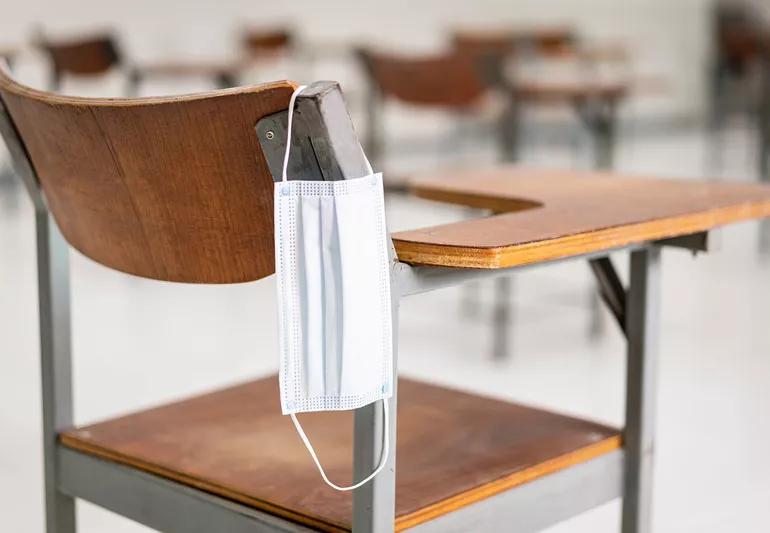Q&A with a Cleveland Clinic physician

Despite mounting scientific evidence and widespread mandates across most of the U.S., skeptics continue to cast doubt on the effectiveness of face masks in reducing the spread of the virus that causes COVID-19.
Advertisement
Cleveland Clinic is a non-profit academic medical center. Advertising on our site helps support our mission. We do not endorse non-Cleveland Clinic products or services. Policy
Aaron Hamilton, MD, MBA, notes that as an institution, Cleveland Clinic has been diligent about evaluating and updating its masking guidelines for patients and caregivers as our understanding of the disease has progressed. The pandemic has also, undeniably, placed healthcare workers in a position of social responsibility inside and outside of the healthcare setting.
Clinicians play a critical role in influencing mask-related behavior, particularly in a one-on-one setting when counseling a patient. There, stresses Dr. Hamilton, clinicians can emphasize mask-wearing as an important part of a patient’s overall health plan, “like a prescription for your health to stay safe in the pre-vaccine, pre-effective treatment COVID-19 era,” he says.
But this scope of influence extends more broadly in social — even social media — contexts, which has thrust many caregivers in the center of masking debates. “The reality is, we have an obligation to our communities and our patients to be good stewards of pandemic hygiene, whether or not we are at work,” he says.
Dr. Hamilton offers a few suggestions for how to approach anti-masking and anti-pandemic arguments:
A: I try to center the conversation on the facts of my experience with the pandemic. We have patients with COVID-19 in our hospital and those who we are closely monitoring outside of the hospital. This is very real for the caregivers working on the frontlines with these patients. It’s very real for patients, and for the families of these patients. As caregivers, we have a close-up view of this pandemic, and it isn’t a political statement for us. It’s the reality of what many of us see when we come to work every day.
Advertisement
A. Sure, some people will say, “Well, the recommendations have changed 10 times. What am I supposed to believe?” And that’s a fair criticism, but it doesn’t change where we are right now. CDC guidelines reflect the information we have available, which has continued to evolve alongside what we’re learning about the virus.
Keep in mind, we didn’t have the benefit of learning about COVID-19 in medical school or residency, or in our own clinical practice. Nobody has ever managed a COVID-19 pandemic before, and, in many ways, we are learning about this together in real-time.
A. A cloth mask isn’t appropriate for children under the age of two, and it may not be appropriate for children with respiratory or cognitive conditions. Aside from that, mask-wearing is something that parents can help socialize and normalize with kids.
I tell parents to start mask hygiene at home, just to get kids used to it. Parents should feel empowered to ask their kids about their feelings on going back to school and wearing a mask. While many school systems are implementing virtual learning programs, mask-wearing will be an important habit for when kids return to the classroom. Try to help them avoid complacency in the meantime. If you can avoid it, the classroom should not be the first time they’re putting on a mask.
Even with adults, some of it is just practice and getting comfortable with mask-wearing, like putting on a seat belt. The more you do it, the more you get used to it until it becomes second nature.
Advertisement
A. Where you are matters. Whether you’re at home, in the grocery store, or out in your community; a cloth mask is effective. When everyone wears masks, we’re all protected.
When you’re in a healthcare environment, some of those dynamics begin to shift. Smaller spaces and vulnerable populations create a greater risk, and therefore, we shift towards procedural or medical-grade masks in those settings.
Of course, this is not new information for caregivers. But it might take a conversation with our patients and/or community members to help them understand implications of risk and face coverings in a healthcare setting.
Emerging literature suggests that, at a population-level, societies more apt to masking practices may have combated the pandemic more effectively. Dr. Hamilton adds that while appropriate masking is crucial, it is just one part of the overall equation.
“There’s certainly evidence that it’s a strong contributor of disease prevention when coupled with social distancing and hand hygiene. We have to think of it as one of the tools in our pandemic toolkit.”
Advertisement
Advertisement

Patients report improved sense of smell and taste

Clinicians who are accustomed to uncertainty can do well by patients

Unique skin changes can occur after infection or vaccine

Cleveland Clinic analysis suggests that obtaining care for the virus might reveal a previously undiagnosed condition

As the pandemic evolves, rheumatologists must continue to be mindful of most vulnerable patients

Early results suggest positive outcomes from COVID-19 PrEP treatment

Could the virus have caused the condition or triggered previously undiagnosed disease?

Five categories of cutaneous abnormalities are associated with COVID-19